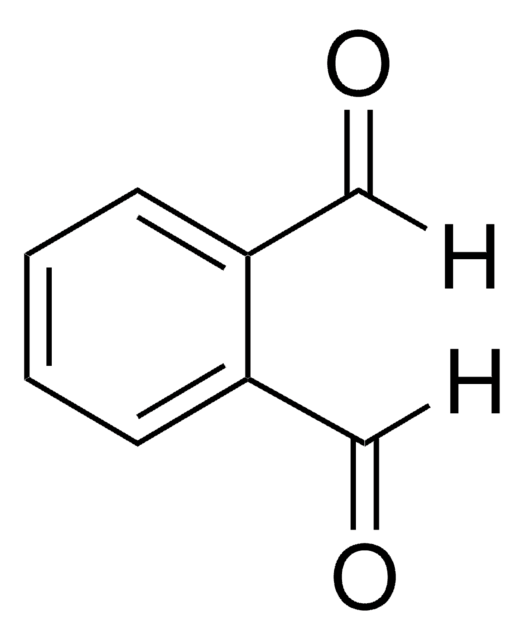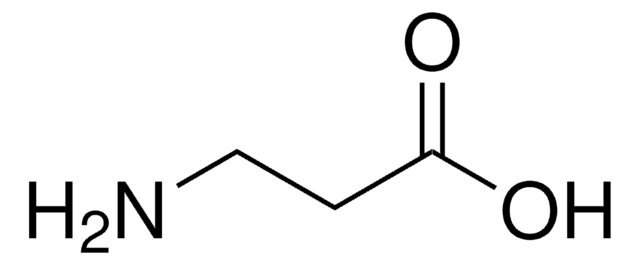G1763
β-Glutamic acid
≥98% (TLC), suitable for ligand binding assays
Sinonimo/i:
3-Aminopentanedioic acid
Autenticatiper visualizzare i prezzi riservati alla tua organizzazione & contrattuali
About This Item
Formula empirica (notazione di Hill):
C5H9NO4
Numero CAS:
Peso molecolare:
147.13
Numero MDL:
Codice UNSPSC:
12352209
ID PubChem:
NACRES:
NA.26
Prodotti consigliati
Nome del prodotto
β-Glutamic acid,
Saggio
≥98% (TLC)
Livello qualitativo
Stato
powder
tecniche
ligand binding assay: suitable
Colore
white to off-white
Stringa SMILE
NC(CC(O)=O)CC(O)=O
InChI
1S/C5H9NO4/c6-3(1-4(7)8)2-5(9)10/h3H,1-2,6H2,(H,7,8)(H,9,10)
BBJIPMIXTXKYLZ-UHFFFAOYSA-N
Azioni biochim/fisiol
β-Glutamic acid (β-Glu) is used as an osmolyte in many archaea. β-Glutamic acid may be used as a substrate to study the specificity and kinetics of archaeal and bacterial glutamine synthetase (GS) enzymes. β-Glutamic acid is used to study primitive mechanisms of polypeptide formation.
Applicazioni
N° Catalogo
Descrizione
Determinazione del prezzo
Codice della classe di stoccaggio
11 - Combustible Solids
Classe di pericolosità dell'acqua (WGK)
WGK 3
Punto d’infiammabilità (°F)
Not applicable
Punto d’infiammabilità (°C)
Not applicable
Dispositivi di protezione individuale
Eyeshields, Gloves, type N95 (US)
Scegli una delle versioni più recenti:
Possiedi già questo prodotto?
I documenti relativi ai prodotti acquistati recentemente sono disponibili nell’Archivio dei documenti.
I clienti hanno visto anche
H McLennan et al.
Neuropharmacology, 21(6), 549-554 (1982-06-01)
Separate receptors are recognized for the excitation of mammalian neurones by (a) L-glutamic and quisqualic acids and (b) N-methyl-D-aspartic (NMDA), and other amino acids which have conformationally restricted molecules. Several other compounds, both agonists and antagonists, have been examined, and
Jean-François Lambert
Origins of life and evolution of the biosphere : the journal of the International Society for the Study of the Origin of Life, 38(3), 211-242 (2008-03-18)
The present paper offers a review of recent (post-1980) work on amino acid adsorption and thermal reactivity on oxide and sulfide minerals. This review is performed in the general frame of evaluating Bernal's hypothesis of prebiotic polymerization in the adsorbed
D E Robertson et al.
Biochimica et biophysica acta, 992(3), 320-326 (1989-09-15)
13C- and 15N-NMR spectroscopy have been used to identify beta-aminoglutaric acid (beta-glutamic) as a major soluble component of the thermophilic, autotrophic marine methanogen Methanococcus thermolithotrophicus. This rare, non-protein amino acid has been recognized as a major dissolved free amino acid
P Robinson et al.
Applied and environmental microbiology, 67(10), 4458-4463 (2001-09-26)
The conversion of beta-glutamate to beta-glutamine by archaeal and bacterial glutamine synthetase (GS) enzymes has been examined. The GS from Methanohalophilus portucalensis (which was partially purified) is capable of catalyzing the amidation of this substrate with a rate sevenfold less
D E Robertson et al.
Applied and environmental microbiology, 56(5), 1504-1508 (1990-05-01)
The unusual compound beta-aminoglutaric acid (beta-glutamate) has been identified by 13C nuclear magnetic resonance spectroscopy in soluble extracts of marine methanogenic bacteria. We examined several methanogen species representing nine genera and found that beta-glutamate occurred in methanococci and two methanogenium
Chromatograms
application for HPLCIl team dei nostri ricercatori vanta grande esperienza in tutte le aree della ricerca quali Life Science, scienza dei materiali, sintesi chimica, cromatografia, discipline analitiche, ecc..
Contatta l'Assistenza Tecnica.








